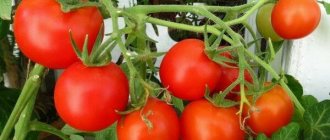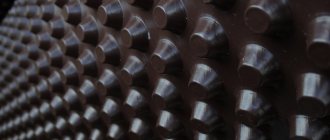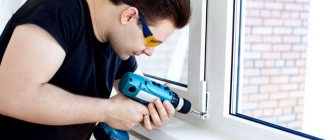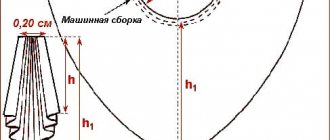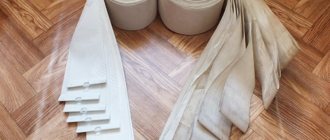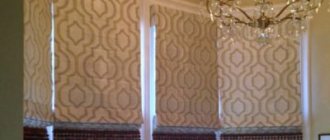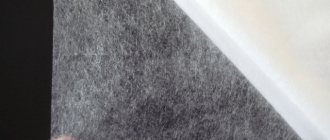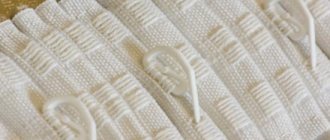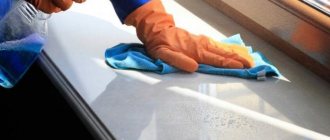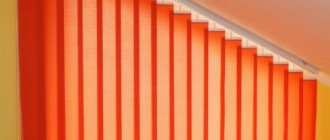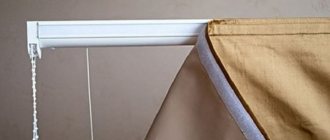Many women like pleated dresses and skirts because they add tenderness and romanticism to their looks. Pleating fabric at home is a simple process, although it requires care. From the resulting material it will be possible in the future to sew products that do not differ from production ones.
Pleating on a template
First you need to make a template, which can then be used repeatedly to pleat the fabric. To do this you will need:
- drawing paper - the size and number of sheets depend on the type of parts;
- fabric with adhesive base;
- long ruler or metal construction meter;
- scissors, pencil, stationery clips;
- iron with steam generation function;
- any heavy load.
Making a template and performing pleating is carried out in the following sequence:
- Draw whatman paper in accordance with the planned width of the folds. It is important to maintain precise markings so that the pleating is smooth and uniform.
- Fold the sheet like an accordion along the marked lines, laying the folds in one direction.
- As folds form, iron them with steam and secure the edges with paper clips.
- Prepare a fabric with an adhesive base (you can take any material and coat it with silicone glue) the same size as the folded paper “accordion”. Glue the fabric to one side of the Whatman paper blank. Iron the template thoroughly and dry it.
- Now you can do it on pleated fabric. Place the material for the skirt or decorative detail into the resulting template and ensure that the folds are even.
- Cover the template with the workpiece with a linen cloth and gently iron it with plenty of steam several times, avoiding movement.
- Place heavy objects on the template and leave to stand for 8-10 hours.
- After the time has passed, remove the pleated.
Natural fabrics should be ironed through a cloth soaked in a fixing solution (stir 20 grams of soap shavings and 2 tablespoons of vinegar in 3 liters of water).
Making pleated pleats at home
A strong recommendation: before taking on such painstaking work, try to look for an atelier or service center where special equipment remains from Soviet times. equipment for pleating! What if you get lucky? If you are sure that your search is fruitless...Then let's get down to business.
The technology is proven, unfortunately it takes a lot of time, the quality is better than when laying pleated molds in Whatman paper. The fabric under the pleats must be checked for creasing; as a rule, those fabrics that leave a slight crease when tested are suitable; if no traces remain, it will be very difficult to iron out the folds. The nuance is that natural fabrics are easier to iron, but they also wrinkle easily. So... 1. the fabric for the skirt is being prepared. It’s more convenient if it’s 2 panels. Length of the panel = length of the skirt + allowance for finishing the top + hem, width = 3x (1/2 hip circumference + allowance for loose fit) + allowance for side seams The width calculation is usual for folds, but I try (if the fabric allows) to include it in calculation 3-4 extra folds for insurance, it is better to cut it off later than not have enough width.
2. On each canvas we process the bottom: we overlay, tuck, the fold is “thoroughly” ironed and stitched. On light fabrics, I make the hem 0.7 cm and place the stitch at a distance of 0.3-0.4 cm from the fold so that the allowance is guaranteed not to “fall”. It’s better not to glue it with cobwebs - it will be too hard. 3. Then, on the front side, I use soap to mark the OUTER fold lines of the folds: the 1st line is drawn at a distance from the edge of the fabric = width of the side seam allowance + 2nd fold depth, 2nd line (and all subsequent ones) at a distance of 3rd fold depth. 4. When the marking is completed, bend the fabric along the first line, pin it across the future seam and sew at a distance of 1 fold depth from the fold (stitch length max for your machine, mine is 6mm), we do not make bartacks, at the end and at the beginning of the stitch leave free ends. Then we bend it in the same way along the 2nd line and so on until the end of the canvas. 5. We repeat the same for the 2nd panel. Making a WTO: 6. First, iron all the INNER folds of the folds. You can do this with a steam iron, I prefer to spray each seam with water and iron it with an “antique” - a heavy 2-kilogram iron. 7. Lay the fabric with ironed folds face down and now use a light steam iron to iron the folds to one side. 8. We make a fixing soap solution, dip a cotton cloth into it, squeeze it lightly and use it to finally iron our folds. We process the canvas 2-3 times. DO NOT MOVE THE CANVAS FROM PLACE. It needs to sit for about a day. 9. Secure the folds with an auxiliary stitch along the upper edge of the fabric 10. Connect the panels along the side seams, with the stitching seam exactly corresponding to the inner “fold” of the fold. This is where our “spare” folds come in handy: we make the first seam focusing only on the cleanliness and correctness of the connection; if something goes wrong, it will be possible to move. Well, let’s specify the second seam “in place”. If there is a slight discrepancy with the top, we tighten the thread on the auxiliary stitch along the top of the fabric. 11. We connect the skirt with the upper part of the dress, overlay the cuts 12. Finally, we remove the threads that were used to stitch the folds at the very beginning (see point 4). Why do we remove it at the end - and it’s easier to fit on a figure and it’s easier to process a straight fabric. In principle, the WTO can be carried out not so carefully, but I worked with regular clients, if you start freeloading, they will run away, but the people are respectable, they brought very expensive fabrics and the suits gravitated towards the classics - i.e. for long wear...
How to restore pleating?
It is necessary to take care of pleated items with special care. Improper ironing or washing may damage the folds.
Before washing, you need to thread the pleated fabric along the hem and in the middle with non-fading threads so that the folds do not become deformed. Place the product in a washing bag and use only delicate cycles.
You can almost always return your favorite clothes to their original appearance, even if the folds are severely damaged. Algorithm for restoring pleating:
- Baste the broken folds along the entire length or fasten them with pins. Starch and leave to dry.
- Meanwhile, prepare the fixing composition. You will need 1 tbsp. l. sugar and gelatin, 100 ml of thick soap solution, 70 ml of table vinegar. Soak gelatin in cold water for 40-50 minutes. After swelling, add sugar to it and stir until dissolved. Then dilute the mixture with soapy water and add vinegar.
- Remove the pins - the folds on the skirt should be held in place by starch.
- Place the product on a sheet of tracing paper and cover with a cotton cloth soaked in a fixing compound. Place another sheet of tracing paper on top so that the impregnation does not stick to the surface of the iron.
- Iron until completely dry. Now the folds will be fixed.
Pleating looks original and elegant on children's and adult items. The technology for creating folds in fabric will help lovers of needlework to significantly expand their creative capabilities.
Preparing the pleated mold
First, you should make a pleated mold, i.e., apply lines for folds at the required distance on a sheet of thick paper. The shape for the skirt should be made in the following order: for ease of folding, draw the first line 2-3 cm from the edge of the paper, then draw lines strictly parallel to the entire sheet of paper, alternating them with each other, for example 2 cm, 1 cm, 2 cm and etc. The slightest inaccuracy in the parallelism of the lines can lead to a distortion of the shape, and therefore the fabric.
Fold the graphed sheet of paper in the desired direction. This should be done like this: fold the sheet of paper upward along the first line, combine the first line with the second, make a fold between them, then fold it along the third line, make a fold, connect it to the fourth and make a fold again.
By bending the paper in this way upward along the odd numbers, lay folds on the entire sheet of paper and iron. You also need to prepare a second sheet of paper. The paper for the form should be 8-10 cm longer than the pleated part. For example, with a skirt length of 75 cm, the length of the uniform should be 80 -85 cm.
It is better to prepare the mold for a pleated frill in two layers of paper with a bend along the length. To do this, draw lines on the top layer of paper from the edge at 2 cm, 1 cm, 0.5 cm, 1 cm, etc., and then make folds on both layers, as mentioned above.
What materials are used for pleating?
A variety of fabrics are suitable for creating pleated fabrics: thick cotton and linen, crepe de Chine, airy silk and chiffon, jacquard, guipure, satin... For warm winter dresses, pleated fabrics made of wool and wool mixture are suitable. A velvet skirt will highlight a stylish autumn look, and a black pleated leather skirt, which is currently at the peak of fashion, will cause a sensation at any party! In addition to all of the above, a pleated skirt can be knitted with knitting needles (it is clear that the technique for performing knitted pleating is very different from the one we will discuss below).
Synthetic fabrics are ideal for pleating because they hold wrinkles well and do not lose their shape after hand washing. It is not recommended to wash natural pleated fabrics - to preserve the shape of the product, it is worth subjecting it only to dry chemical treatment (simply, dry cleaning).
To keep the product in its original form for as long as possible, it is worth choosing large folds for dense fabrics, and small ones for thin and airy ones.
Model differences in length
The range of pleated and pleated skirts is wide, because this solution looks interesting regardless of the length of the product. There are four standard length options:
- maxi;
- midi;
- mid-length skirt;
- mini.
Corrugated dress
For any length, it is important to choose the appropriate type of fabric and color scheme. When buying a ruffled dress, take into account your body type.
So, a miniskirt will fit well on the owner of narrow hips and broad shoulders. Many people associate folds with school uniforms. Dense material is usually used for sewing. If the corrugated edge barely reaches the knee, we are talking about a medium length. There is a wider choice of fabrics here; airy chiffon and organza look good.
A similar variation in the types of fabrics is observed in midi-length skirts that reach the knees. Dense or weightless pleating will look equally good on a girl with a narrow waist and long, slender legs.
Many women decide to wear a conservative maxi, and for good reason - an outfit below the knee or to the floor will only emphasize the femininity of its owner. To create the longest hemlines, airy fabrics are often used: chiffon, taffeta, organza. Silk and crepe flow beautifully.
Pleated dress
Where are folds used?
Corrugated and pleated fabric is a favorite tool not only for fashion designers, but also for interior designers in Stavropol. Folds are used when sewing the following items:
- skirts of different lengths;
- dresses;
- blouses;
- curtains and blinds.
Note! Pleating is especially relevant in the warm season. Light, airy materials make weightless dresses that visually lengthen legs due to straight lines formed by corrugation.
Ruffled skirt
If blinds have recently faded into the background, then the use of pleated curtains is only gaining momentum. This is not surprising if we remember the advantages of such curtains:
- Pleated curtains are often placed on attic and roof windows. By installing a remote control, the home owner can lower and raise the curtains at his discretion.
- Vertical and horizontal folds completely change the visual perception of rooms. Vertical ones make the room taller, and horizontal ones make the room more spacious.
- Corrugated curtains are easy to decorate inclined surfaces.
You might be interested in How to sew fabric puffs yourself
Pleated skirt
Pleated and corrugated designs are of interest not only to fashion connoisseurs, but also to those who are interested in interior design. Pleated fabric makes you look at things in a new way.
Pyramid corrugated shapes
There are 3 types of corrugated forms:
- linear;
- pyramidal;
- decorative.
Clothing with corrugation of different shapes.
The pyramidal shape deserves special attention. This is what is most often used to make fabric for clothing. This shape is characterized by alternating different stripes - wide and narrow. To implement it, you need to immediately calculate how many stripes should fit in order for the finished product to look beautiful.
Corrugated fabric in the product
How to wash corrugated items
Washing corrugated fabric is somewhat different from washing regular items. Therefore, there are a number of rules for this process:
- Sew folds. Before throwing it in the wash, you should sew each fold in the middle and at the very bottom. Make the seam wide and under no circumstances tighten it so as not to spoil the item.
- Preferably choose hand washing.
- If, after all, the product is machine washed, then you must turn off the spin cycle and wash only in the delicate mode.
- To avoid unnecessary bruises, you can wash the item in a special cover (can be replaced with a nylon stocking).
- It is better to wash using conditioner. This will help make the fabric more pliable and avoid electrification.
- You should wring it out as delicately as possible, without squeezing the fabric too much; if it is something bulky, for example, bed linen, then it is better to immediately lay it out on a flat surface.
- It is most important to study what is written on the product label.
You may be interested in Constructing sweatshirt patterns for men, women and children
A skirt that requires special care
Types of pleated curtains
There are five main types of pleated curtains. They are divided mainly depending on the design. In addition, there is a division according to the materials from which they are made.
Pleated blinds provide excellent protection from the sun and heat from the street.
- For windows with tilt-and-turn opening mechanisms, free models are made. In this case, the windows should be standard, with a strict geometric shape. Pleated curtains flow freely over such frames.
- Tension pleated curtains are equipped with a special fishing line at the edges, thanks to which free sagging of the curtains is excluded. There is no sagging on horizontal surfaces, but on inclined roof windows the fishing line is simply irreplaceable. In addition to attics, slanted windows are often found in flower greenhouses.
- Pleated roller blinds are equipped with a rotating shaft. It is to this that the upper part of the curtain is attached. The chain (similar to that found in blind models) allows you to roll up and unfold the canvas in one movement. In this way, the degree of transparency of the canvases and the degree of illumination of the room are regulated.
- "Day Night". These curtains are multi-layered. The design, as a rule, combines two fabrics: one is translucent, and the second is dense. They are highly functional: during the day you can move the thick part and leave only a translucent curtain on the window opening, and in the evening you can close the second curtain. In essence, day-night curtains resemble a classic pair of curtains and tulle.
- "Top bottom". Another interesting model. Its fundamental difference from the previous ones is the presence of guides and side mechanisms. The curtains can be pulled back either from below or from above. In this case, any gap can be selected. This model allows you to adjust the level of illumination in the room and close the window as much as necessary at the moment.
They do not allow the room to heat up too much on a hot summer day, and also protect the room’s furnishings from fading.
The structure of the fabric of pleated curtains can be very different. There are regular and corrugated fabrics. The corrugated curtain has double folds, that is, convex compartments are located on both the front and back sides, and air compartments remain between the layers of pleated material. Such canvases retain both light and heat. In other words, pleated curtains will provide maximum protection from the sun, which is why they are especially in demand for south-facing windows. In addition, pleated pleated curtains guarantee good thermal insulation.
The distinctive features of this type of blinds include the fact that they can be washed right at home.
Whatever the material of such curtains, they have one thing in common: they are attached to a metal (aluminum) profile. The basis for pleated curtains can be purchased at stores that supply curtains, and suitable material can be found in a specialized store. Well, if you want to make curtains from paper, you can find a suitable option in craft stores.
Choosing clothes to match a pleated skirt
When wearing a pleated skirt, it is very important to understand that despite the long vertical lines, which are usually supposed to slim and lengthen the silhouette, it visually adds centimeters to the hips. Therefore, the figures suitable for such clothes are thin girls, or girls with broad shoulders.
For short stature, it is better not to choose very long models, they will visually reduce your height even more.
At the same time, a pleated skirt is a universal item in the wardrobe that can be worn with anything. It will be ideally combined with a T-shirt and a warm sweater. In addition, even long outerwear with such a skirt will look as stylish as possible. Products made from different textures (for example, chiffon and wool) will also combine beautifully.
Bows with skirts
In cold weather, a pleated wool skirt with a fur vest goes very nicely, and you can brighten up the look with bright accessories. Fashion experts also believe that products with lurex thread are appropriate in cold weather. In warmer times, you can wear a jacket or jumper on top. It is appropriate to wear a blouse under a skirt for the office.
Note! Shoes for such a skirt can also be absolutely anything: sandals, ballet flats, high-heeled shoes, sneakers and even sneakers.
The most popular skirt option is still a midi. With it you can create as many images as possible. It can be either a pencil style, a trapezoid, or a sun. Recently, asymmetrical models have also begun to come into fashion.
Designers advise choosing pleated skirts in rich colors or, conversely, diluting the calm colors of the skirt with a bright top, shoes or accessories. All fashion catwalks are now filled with corrugated fabrics, so while viewing the shows you can choose an interesting modern look for yourself.
Look options for any weather
